Archives Home Page Buildings Home Page
![]()
| From 1904 until 1952, St. Bonaventure was home to a farm. It was located on the floodplain by the river, which today serves as the university's athletic fields. Managed by students, the farm was responsible for providing food for the university's residents. At its peak, the farm was home to 65 cows and 600 pigs, and it produced 6000 bushels of potatoes and 1500 bushels of oats per year across its 200 acres. Originally, the farm stretched into what is considered main campus today. Built in 1912, the farm's original barns and greenhouse were located behind Butler Gymnasium. | |
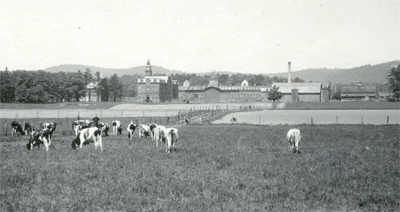 |
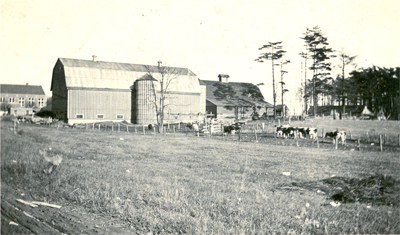 |
| View of St. Bonaventure's campus in the 1920s, seen from the pastures, which today are the athletic fields. The original barns can be seen on the right hand side of the photo. | A closer view of the original barns, located behind Butler Gym and the Power Plant. Butler Gym can be seen in the background on the left hand side of the photo. |
![]()
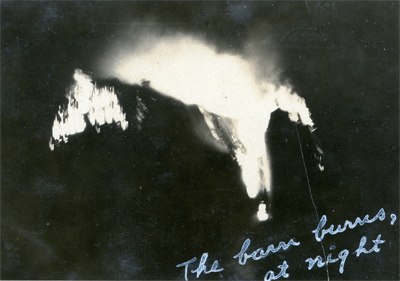 |
On October 21, 1930, the main barn on
campus caught fire. It was the second fire in six months to occur at St.
Bonaventure. The cause of the fire is unknown, but it completely
destroyed 40 tons of hay, 20 tons of feed, 1600 bushels of oats, a grain
reaper, and 2 silos, one of which was filled at the time.
When the fire was discovered at 6:30PM, the college students, priests, and seminarians quickly sprang into action. They successfully led the 30 head of cattle that lived in the barn to safety, and they set up a hose line in an attempt to save the barn. When this proved to be hopeless, the campus community turned its attention to preventing the fire from spreading to the other buildings. Altogether, the fire caused $12,000 worth of damage. |
| Scene of one of the original barns (pictured above with silo) burning Oct. 21, 1930. |
![]()
| After the fire, the location of the college's barns slowly shifted. In the late 1920s, a piggery had been constructed in the far corner of St. Bonaventure's property near the river, approximately where the Rugby field is today. After the main barn on campus was destroyed, the college built new barns near the piggery. The new main barn stood where the Maintenance Building stands today, and it housed the cattle and the workhorses. The college also built two smaller storage barns in between the piggery and the main barn. | |
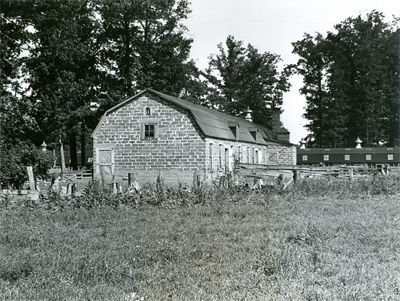 |
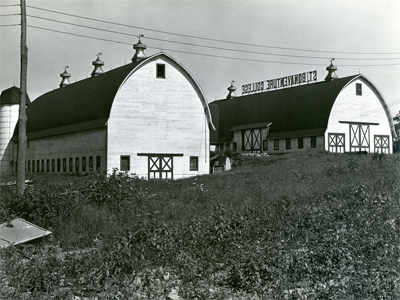 |
| The piggery, located near where the rugby field is today, was built in the late 1920s. | The main barn, which was located where the Maintenance Building stands today, was built it 1931. It housed the draft horses and cattle. |
 |
 |
| One of two smaller storage barns, located between the main barn and the piggery. | The College's team of draft horses pull equipment from the main barn. Photo courtesy of Francis "Griff" Griffin. |
![]()
| "The Great Pig Rescue" | |
| In the the spring of 1942, days of heavy
rain caused the Allegheny River to escape its banks, flooding the lower
part of the farm. The piggery, which was the barn closest to the river,
was soon chest-deep in water, leaving 150 pigs trapped inside. In order
to rescue them, several clerics and college students came up with the
idea to use a large wooden tub that housed ducks as a life raft.
Stringing a sturdy line from shore to the piggery, the Bonaventure
community labored for twelve hours to ferry the drowning pigs to safety.
Throughout the course of this rescue mission, only one pig was lost. The
rest, including a 600-pound boar, were safely rafted to shore. For the complete story, as told by Fred McCarthy, click here. |
|
 |
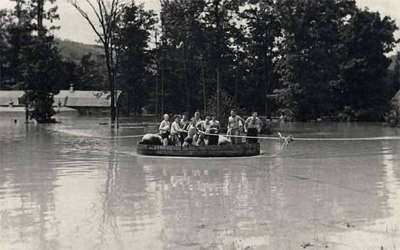 |
| Students rescuing the pigs in the
aftermath of the 1942 flood. The small storage barns can be seen in the
background. Fred McCarthy is on the left in the photo. |
Students continuing the pig rescue. The piggery can be seen in the background. |
![]()
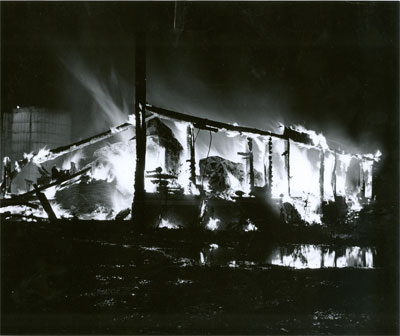 |
By 1970, the barns were no longer being
used to house animals. The farm had ceased to exist in the early 1950s
due to a lack of student assistance in maintaining it. The main barn's
new purpose was to store supplies for the campus ROTC, as well as
various athletic equipment.
On November 4, 1970, at 1:20am, the main barn caught fire. The barn and all of its contents were destroyed, causing a total of $115,000 in damage. Although the fire was initially presumed to be spontaneous, the discovery of empty gasoline cans and rags in the vicinity of the barn prompted an arson investigation. Due to the fact that an ROTC vehicle was destroyed in the fire, the FBI entered the investigation as well. The fire was most likely linked to the tension on campus related to the ongoing controversy surrounding the intervisitation rules at the university. Intervisitation between male and female dorms had recently been banned, causing a rift between the students and the university administration. However, no arrests related to the fire were ever made. To this day, the exact circumstances of the fire remain unclear. |
| The main barn burns, November 1970.
Photograph by the Olean Times Herald |
|
| After the fire in 1970, the remaining barns slowly began to disappear from campus without much fanfare or notice. In fact, there are few records regarding exactly when the barns were demolished. By 1978, the only barn remaining was the piggery. It is believed to have been demolished in 1985. | |
![]()
Back to Top Archives Home Page Buildings Home Page
Page created by Ellen Winger, Spring 2010.
Last update: 07 Sep 2010